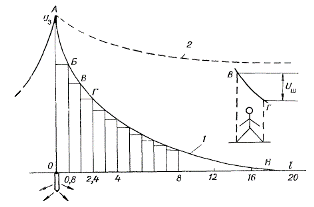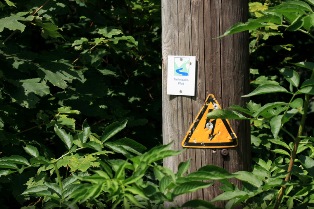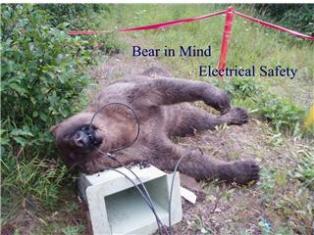What is step voltage
Step voltage (step voltage) is called the voltage between two points of the current circuit, located from each other at a distance of a step, on which a person stands at the same time. The step voltage depends on the resistance of the soil and the strength of the current flowing through it.
A step voltage is the voltage between two points on the ground at a step distance that occurs around the point of a ground fault in a live line. The greatest value of this voltage is observed at a distance of 80 — 100 cm from the point of contact of the wire with the ground, after which it rapidly decreases and at a distance of 20 m practically becomes equal to zero.
In the field of protective devices against electric shock - grounding, grounding, etc. — of interest are primarily the voltages between points on the surface of the earth (or other ground on which a person stands) in the area of current propagation from a grounded electrode.
Very often touch voltages and step voltages are confused.Touch voltage is the potential difference between two points of an electrical target that are simultaneously touched by a person, and step voltage is the voltage between two points on the earth's surface in the current propagation zone, separated from each other by a distance of one step.
Step voltage with single ground
The step voltage is defined by a segment whose length depends on the shape of the potential curve, i.e. of the ground electrode type and varies from a certain maximum value to zero with a change in distance from the ground electrode.
Suppose that an earth electrode (electrode) is placed in the earth at point O and the earth fault current flows through this earth electrode. Around the grounding electrode, a zone of current propagation along the ground is formed, i.e. the grounding zone, outside of which the electric potential due to the ground currents to the ground can be conditionally assumed to be zero.
The reason for this phenomenon is that the volume of ground through which the ground fault current passes increases with distance from the earthing conductor as the current propagates into the ground. At a distance of 20 m or more from the grounding electrode, the volume of the earth increases so much that the current density becomes very low, the voltage between points on the earth and points still further away is not detectable in any perceptible way.

Voltage distribution at different distances from the grounding electrode: 1 — potential curve 2 — curve characterizing the change in step voltage
If you measure the voltage Uz between points located at different distances in each direction from the ground electrode, and then build a graph of the dependence of these voltages on the distance to the ground electrode, you will get a potential curve) If you break an OH line in sections of length 0.8 m, which corresponds to the length of a person's step, then his feet can be at points of different potential. The closer to the ground electrode, the greater the voltage between these points on the ground (Uab > Ubv; Ubw> Ubd)
The step voltage for points C and D is defined as potential difference between these points
Uw = Uv — Ur = Usb
where B — the step voltage factor, taking into account the shape of the potential curve 1. The largest values of step voltage and factor B will be at the smallest distance from the grounding electrode when a person stands with one foot on the grounding electrode, and the other leg is staggered.
Curve 2 characterizes the change in step voltage.
Dangerous step voltages can, for example, occur near a live conductor that has fallen to the ground. In this case, it is forbidden to approach the wire lying on the ground at a distance closer than 8 — 10 m.

There is no step voltage if one is standing either on a line of equal potential or outside the current dissipation zone.
Maximum step voltage values will be at the smallest distance from the ground electrode when a person stands with one foot directly on the ground electrode and the other foot at a distance of one step from it.This is explained by the fact that the potential around the grounding electrodes is distributed along concave curves, and therefore the biggest difference is, as a rule, at the beginning of the curve.
The smallest values step voltage will be at an infinitely large distance from the grounding electrode, but practically outside the field of current propagation, i.e. over 20 m. There will be no step voltage when one is standing in the area of low (close to cool) potentials, on a line of equal potential or on one foot (therefore it is recommended to leave the current splash area by jumping on one foot and placing per leg on a line of equal potential).
Step voltage with group ground
In the area where the group ground electrodes are located, the step voltage is less than when using a single ground electrode system. The step voltage also changes from a certain maximum value to zero — with the distance from the electrodes.
The maximum step voltage will be, as with a single earth, at the beginning of the potential curve, i.e. when a person stands with one foot directly on the electrode (or on a piece of ground under which the electrode is buried) and the other foot at a distance of a step from the electrode.
The minimum step voltage corresponds to the case when a person stands on «points» with the same potentials.
Danger of step voltage
If grounding is detected before disconnecting the damaged section, it is forbidden to approach the location of the fault at a distance of less than 4 — 5 m in closed switchgear and 8 — 10 m in open substations.If necessary (for example, to eliminate the accident, to help the victim), you can approach the place of damage at a shorter distance, but you must use protective equipment: boots, galoshes, carpets, wooden ladders, etc. .n.
When step stress occurs, involuntary convulsive contractions of the leg muscles occur, and as a result, a person falls to the ground. At this moment, the action of the step voltage on the person ceases and a different, more difficult situation arises: instead of the lower loop, a new, more dangerous current path is formed in the human body, usually from the hands to the feet, and a real threat of fatal electric shock. If you fall into the zone of action of the step voltage, you must leave the danger zone with minimal steps ("goose step").

Walking stress is particularly dangerous for cattle, because the distance these animals take is very long and the stress they are under is great. Cases of livestock dying from step stress are not uncommon.
